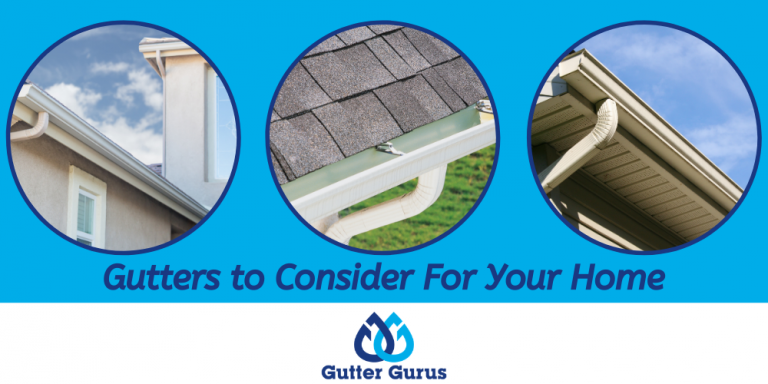Hey, I am Leafie. Are you looking for an instant gutter price?

Believe it or not, there are quite a few types of gutters to choose from when you’re considering replacing your home’s rain gutters.
The exterior of your house has a lot of important parts that safeguard its overall health, and while you’ve heard of the one, in particular, we are going to talk about today, gutters, the important question is how much do you really know about them and the types of material they are made out of?
Chances are you aren’t too familiar, and if that’s the case and you ended up here, you made a good choice!
Even for the most knowledgeable DIY out there, getting into the nitty-gritty of the details you need to know about the material and composition of gutters can be a challenge and pays a heavy price in time, money, and peace of mind if you make the wrong choice!
Today, the class is in session, so listen up! We will give you a crash course of the types of gutter materials out there, their future implications down the road, and for the fun of it, a couple of gutter styles you may see on your house or while out and about. Let’s Go!
Four Main Types of Gutters:
Aluminum
Pros: Aluminum gutters are one of the most common gutter materials out there actually. They are strong, durable, resistant to rust, and can withstand the elements for many, many years, so exaggeration on that! The process to install them is incredibly easy because of their lightweight feature.
With Aluminum, you can get the opportunity to be creative with them if you are into that since you can paint them.
Cons: Despite being able to last quite a long time, one of the downfalls of aluminum gutters is that they can dent or bend, which on the surface is a cosmetic issue more than a critical, foundational one.
Note: Here at Gutter Gurus of NOVA, we exclusively install seamless aluminum gutters that are custom fit on site. You can use our FREE gutter calculator and get pricing done online, no hassle!
Steel
Pros: Steel gutters are one of the strongest materials out there that makes a phenomenal choice in their ability to endure and withstand the elements. Just like the Aluminum ones, you can paint it if you so choose.
Cons: The steel composition of the gutters is not exactly compatible with moisture, making it prone to rust. Furthermore, it is pretty dense compared to its counterparts which makes it very heavy and therefore, rather difficult to install yourself.
Vinyl
Pros: Vinyl, like aluminum, are a very common material found on most houses! They are incredibly easy to install and honestly one of the cheapest materials out there to use. Vinyl does not have metallic properties which are prone to rust and/or corroding due to exposure to the elements. Feel free to paint it as you like as well!
Cons: Vinyl, despite its incredible convenience, vinyl is not a long-lasting material as it tends to break down and crack after being exposed to intense heat and cold. Exposure to prolonged sunlight can mellow its color over time. Also, maintenance can be a recurring theme as it can stand a finite amount of pressure. Read more about vinyl vs aluminum here.
Note: Here are Gutter Gurus of Northern, VA – we do not recommend vinyl gutters for your home. The extreme cold in the winter, the hot summers, the heavy rains, and countless other factors make life on your home’s rain gutters hard as it is. Vinyl gutters simply can’t get the job done in Virginia.
Cooper
Pros: Copper gutters are a cosmetic wonder that gives off an old-fashioned, traditional look! They are very suitable in all types of weather and are not prone to rusting or wrapping. Over time, the pigment of the copper turns into a beautiful, enigmatic green patina, so there’s really no need to paint. Very convenient!
Cons: Copper gutters, despite their beauty, is a very expensive choice, averaging between $15-$25 per linear foot. It is important to keep in mind that copper has a higher density than most materials, which thus means it is not very DIY friendly.
Styles of Gutters
K-Style
K-Style Gutters are one of the most common styles you’ll see on today’s houses that can be directly attached to the fascia board on your house’s exterior. They are more apt to carry more water and are a suitable choice of regions with rainy climates and have a unique cosmetic appeal due to its shape and structure.
On the other hand, you may find your cleaning job a bit more common and challenging from time to time as they are prone to collect debris and organic matter.
K-Style gutters are also some of the best for maintenance-free gutter guards. While gutter guards are not all created the same, Raindrop gutter guards are self-cleaning and hassle-free!
Half Round
Half Round gutters are more traditional, old-fashion style gutters that are typically found on homes that were constructed prior to 1960. Very convenient in that they are resistant to being clogged by leaves and other organic matter. Half-round gutters are designed in a way to efficiently carry, distribute, and expel water after a period of rain.
Although unlike other styles of gutters, they don’t sit adjacent to fascia boards, rather they are fortified by brackets that keep them sturdy and in place. Also, they aren’t as decorative as its K-Style counterparts, which leaves the cosmetic appeal something to be desired.
The Verdict:
Today, you learned a lot about the composition and properties of gutter materials out there and truth be told, being aware of important details has prevented some major blunders and will do so here! All materials are not the same in terms of the value it will bring to your home. While cheap, quick, and easy sounds good now, it doesn’t sound good necessarily down the road.
Every house is different, which thus means every house will require a different approach. If you got it, hey more power to you! However, if you have any questions or are unsure about particular details get in touch with our gutter resources here below and we’ll be happy to assist you!
Also, be sure to check out the following gutter related information:
- Got a gutter question? FAQ Gutters Here
- Need a price? Gutter Calculator Online
- Want to learn more? Gutter Learning Library

